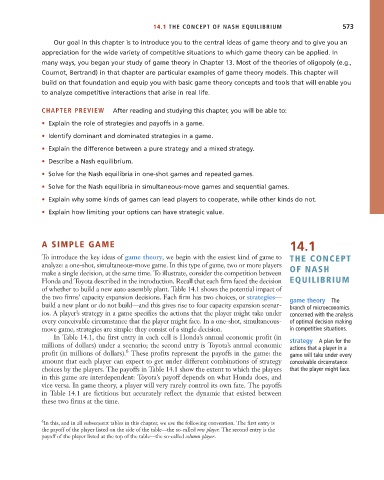Page 599 - Microeconomics, Fourth Edition
P. 599
c14gametheoryandstrategicbehavior.qxd 8/6/10 8:22 AM Page 573
14.1 THE CONCEPT OF NASH EQUILIBRIUM 573
Our goal in this chapter is to introduce you to the central ideas of game theory and to give you an
appreciation for the wide variety of competitive situations to which game theory can be applied. In
many ways, you began your study of game theory in Chapter 13. Most of the theories of oligopoly (e.g.,
Cournot, Bertrand) in that chapter are particular examples of game theory models. This chapter will
build on that foundation and equip you with basic game theory concepts and tools that will enable you
to analyze competitive interactions that arise in real life.
CHAPTER PREVIEW After reading and studying this chapter, you will be able to:
• Explain the role of strategies and payoffs in a game.
• Identify dominant and dominated strategies in a game.
• Explain the difference between a pure strategy and a mixed strategy.
• Describe a Nash equilibrium.
• Solve for the Nash equilibria in one-shot games and repeated games.
• Solve for the Nash equilibria in simultaneous-move games and sequential games.
• Explain why some kinds of games can lead players to cooperate, while other kinds do not.
• Explain how limiting your options can have strategic value.
A SIMPLE GAME 14.1
To introduce the key ideas of game theory, we begin with the easiest kind of game to THE CONCEPT
analyze: a one-shot, simultaneous-move game. In this type of game, two or more players
make a single decision, at the same time. To illustrate, consider the competition between OF NASH
Honda and Toyota described in the introduction. Recall that each firm faced the decision EQUILIBRIUM
of whether to build a new auto assembly plant. Table 14.1 shows the potential impact of
the two firms’ capacity expansion decisions. Each firm has two choices, or strategies— game theory The
build a new plant or do not build—and this gives rise to four capacity expansion scenar- branch of microeconomics
ios. A player’s strategy in a game specifies the actions that the player might take under concerned with the analysis
every conceivable circumstance that the player might face. In a one-shot, simultaneous- of optimal decision making
move game, strategies are simple: they consist of a single decision. in competitive situations.
In Table 14.1, the first entry in each cell is Honda’s annual economic profit (in
millions of dollars) under a scenario; the second entry is Toyota’s annual economic strategy A plan for the
actions that a player in a
6
profit (in millions of dollars). These profits represent the payoffs in the game: the game will take under every
amount that each player can expect to get under different combinations of strategy conceivable circumstance
choices by the players. The payoffs in Table 14.1 show the extent to which the players that the player might face.
in this game are interdependent: Toyota’s payoff depends on what Honda does, and
vice versa. In game theory, a player will very rarely control its own fate. The payoffs
in Table 14.1 are fictitious but accurately reflect the dynamic that existed between
these two firms at the time.
6 In this, and in all subsequent tables in this chapter, we use the following convention. The first entry is
the payoff of the player listed on the side of the table—the so-called row player. The second entry is the
payoff of the player listed at the top of the table—the so-called column player.

